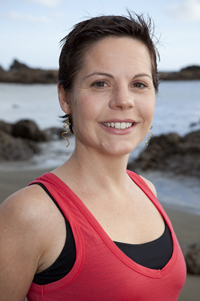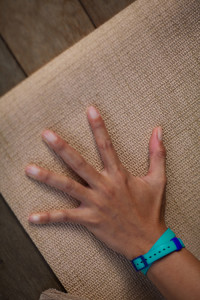by Kelly Fisher, Urban Yoga
Kelly is our resident yoga teacher mentor, answering questions from readers about how to teach and what to do when issues come up. You can email Kelly your question here.
The Yoga Teacher’s Question:
“There it was yesterday: my first and rather frustrating setback in my teaching experience.
I have a student who suffers from a lot of wrist pain. She comes along to my 45 minute class that is short, sharp and energetic. Because I know she requires special preparation, I planned the class to include some gentle wrist warming-up and massaging before the more general warm up (cat/cow, dog, a couple of flowing vinyasas). For plank / chatturanga I had suggested to go via knees.
It was all going ok until she suddenly jumped out of her posture saying:
‘Ohhhh – always these sun salutations and this pain. If it continues like this, I think I won’t come any more.’
I was shocked and went to help her, trying to calm her down. Meanwhile, everybody was waiting in Uttanasana so I cued them out, had her take child’s pose and tried to find my own poise again.
My question to you: What could I have done to prevent this? Something different or better?
I had in previous classes given her options should she feel pain at any moment. How should I deal with that in future? I can and am happy to do without downward facing dog or chatturanga or any kind of wrist inclusion. I would prefer not to always do this because there are other students and in a short class, I find sun salutations very useful to warm up quickly.”
Kelly our Yoga Teacher Mentor Gives her Answer:
“I’m sorry to hear that happened for you. It’s shocking and somewhat hurtful when you take the time to prepare and offer a class with someone’s specific needs in mind only to have that person be publicly negative about your class. I think you handled it as well as you could have in the moment. You’re right, you had the other paying students to think of and you’d done quite a lot in a short group setting to prepare wrists for what followed.
When someone is that rude and inappropriate, it’s a sure sign they’re suffering in themselves with something that has nothing to do with you or the class. As the conduit and space holder, remember outbursts like that are more about them than they are about you. While teaching yoga is deeply personal, you needn’t take on your students’ personal challenges as your own. An outburst can be an opportunity to acknowledge the student’s suffering and the effort she’s putting in while also empowering her and the rest of the group.
A complaint about wrist pain, even after warming up, is the perfect opportunity to teach or remind her and the class about the foundation through the hands and the balance of push/pull through the arms. Usually, your wrist sufferers aren’t employing hasta bandha (hand lock/seal) or a good mix of muscular and organic energy.
Ensure students have placed their hands with the wrist creases parallel to the top of the mat or for those with tight shoulders, hands can be turned out slightly.
For best results, students must ground well through the full circumference of their palms, especially the inner edges and index finger knuckles. Also, make certain that the students are grounding through the length of each finger, right out to the fingerpad (the fingernail bed will get a little paler than normal when this is happening well).
From that foundation, have them engage the muscles of their arms, with a sense of pulling the muscles up the arms all the way to the center of their upper back. Once that engagement is in place, instruct them to push from the center of their upper back down through their bones all the way out through the foundation in the hands.
It will take a little time but the learning will go a long way for many students, particularly in the type of class where weight bearing through the hands and arms is often the norm.
Another thing to think about as well is shoulders. Wrist pain and shoulder tightness are often linked. Your student with the wrist issue could need more shoulder warming up and opening too.
In a short group class there’s only so much ‘warm up’ you can do so she might need to take ownership of doing a few things to prepare her body before the class if she wants to participate. It sounds like she’s still not taking ownership with the options you’ve mentioned so it could be a matter of discussing them again with her and encouraging her to feel empowered to modify for her needs/prepare her body to play in your session.
Also, perhaps the student might be better served with some one to one sessions with you and some home practice until her wrists heal enough and she develops enough skill to join your group class.
Do you offer private sessions or would you feel comfortable offering them to her? As much as we’d like to welcome all people to all classes, the truth is some classes can be inappropriate for beginners or folks with injuries.
Yoga is not one-size-fits-all and in a short class geared to be sharp and energetic, there is a base level of skill required to participate safely.
I’ll leave you with a quote from Oscar Hammerstein II:
‘If you become a teacher, by your pupils you’ll be taught.’
Your students will teach you so much when they make you uncomfortable or when you feel out of your depth.
By stopping to ask the questions you’ve asked, you will learn exactly what you need to learn from this situation.
It might be useful to reflect further on your own emotions around how she spoke out in class and also on any experiences you’ve had being frustrated in yourself, whether due to physical discomfort or otherwise.
Cultivating a sense of compassion for her suffering will serve you, her and your future students beautifully.
If you have any questions or comments about this article, please contact Kelly direct by sending her an email.
About Kelly
 Kelly Fisher, e-RYT 500, has made yoga her full-time career since 2005 having spent most of the previous decade in big business IT and part of the decade before that studying Neuropsychology.
Kelly Fisher, e-RYT 500, has made yoga her full-time career since 2005 having spent most of the previous decade in big business IT and part of the decade before that studying Neuropsychology.
She is the owner of Urban Yoga, the co-founder of Yoga Unlimited,Wellington’s first upmarket yoga and wellness retreat and the catalyst behind Wellington’s offering of the first couple of years of the Global Mala event.
Over the course of her yoga career, Kelly has studied with many teachers from various lineages including Iyengar, Astanga, Satyananda, Prana Flow and Anusara and has investigated related sciences Ayurveda, Acupuncture and Craniosacral therapy. She is grateful for the support and advice she has had on her journey.
